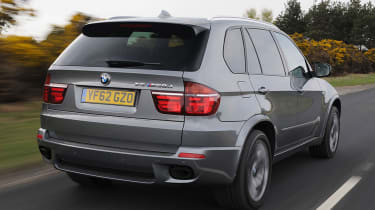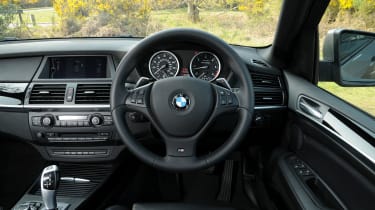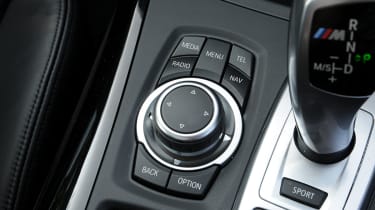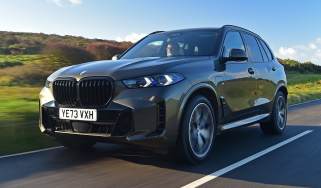Used BMW X5 buying guide: 2007-2014 (Mk2)
If you want a go-faster SUV, the BWW X5 is one of the best, and it makes a good used buy, too
It’s hard to remember, but the original BMW X5 was quite a departure from the SUV norm when it was launched at the end of the 1990s. While most of its rivals were heavy, bulky machines with a separate chassis and ponderous road manners, the X5 was far more car-like. It was also responsible for many well-heeled families trading their luxury estate cars for an SUV.
The second generation of BMW X5 – launched seven years after its hugely successful predecessor – added polish and an extra helping of practicality. For the first time, the X5 offered an optional third row of seats for two children. Off-road use had slipped further down the X5’s list of priorities – the big alloy wheels and low-profile tyres were very much optimised for the tarmac – but with terrific handling for such a large car, the X5 grew ever more popular.
Despite having now been replaced by a third-generation X5, the Mk2 remains in high demand, and values on the used market are strong. This means it’s more expensive to buy used than some of its rivals, but its capabilities really aren’t far from matching those of the current version.
With a broad range of models offered, choosing a Mk2 X5 - which was codenamed E70 by BMW - isn’t entirely straightforward. There are also a few important points to check for your X5 ownership experience to bring pleasure without too much financial pain.
More reviews
Here’s our buyer’s guide to choosing the best Mk2 BMW X5.
History
The Mk2 BMW X5 was launched in 2007 with a choice of three engines; 3.0-litre, six-cylinder petrol or diesels and a flagship 4.8-litre petrol V8 that offered formidable acceleration. Diesel fans were treated to a performance boost soon after, with a 286bhp ‘SD’ version of the 3.0-litre diesel engine.
A new badging regime was introduced in 2008, focusing on the name of BMW’s xDrive four-wheel drive system. Diesel models were henceforth known as xDrive30D and xDrive35D, while petrol versions were xDrive30i and xDrive48i. An extremely powerful twin-turbocharged 4.4-litre V8 petrol model, the X5 M was launched in April 2009, with 555bhp to its name.
BMW freshened the styling of the X5 in June 2010, with reshaped headlamps and bumpers, while the xDrive35d was replaced by the 302bhp xDrive40d.
Which is the best X5 Mk2 version for me?
Fuel economy is not a strong suit of any BMW X5. The diesels are by far the most frugal, The later xDrive40d could manage 37mpg, but the entry level xDrive30d is unlikely to return much more than 32mpg. The 3.0-litre petrol engine can return up to 28mpg if driven calmly, but the 4.8-litre V8 has to be driven very gently indeed to show you more than 20mpg. Annual road tax charges are intimidating, too, no thanks to high CO2 emissions.
The X5 is a comfortable car, although wheel choice can have a pronounced effect on ride quality. We recommend avoiding wheels bigger than 18-inches in diameter, as their tyres are less able to absorb bumps. The same is true of the stiffer suspension found on Sport models – the SE has far softer springs and a more soothing ride.
An eight-speed automatic gearbox was introduced in 2010 and cars fitted with them are worth more than their six-speed predecessors. They’re worth seeking out if your budget allows, though, they’re more responsive and the extra gears help in coaxing a little more fuel economy from the engine.
Running costs, maintenance & parts
As with many BMW models, servicing is based on a set of sensors and an on-board computer, which indicate on the dashboard when to book the car into a garage. An X5 can go for up to 20,000 miles or two years between visits, depending on the kind of driving you do, but expect to pay around £400 when a service is needed. All X5s have chain-driven camshafts, so you don’t need to worry about expensive cambelt changes.
Try to find a car with a pre-paid service plan, as these can be passed down to new owners, or consider taking one out with a BMW dealership, as they tend to offer good value and help budget for expenses.
Fuel consumption for the petrol range is just 22mpg for the V8 models, improving to 26mpg for 3.0-litre versions. Diesel economy is better, with 32mpg for an early 3.0-litre or 37mpg for the more advanced xDrive40d. Tax and insurance are important considerations, too, with high emissions equating to road-tax bills of between £295 and £515 a year, while every X5 is in insurance group 40 or above.
What to look out for
It’s hugely worthwhile holding out for an X5 with a full main dealer service history, with all maintenance carried out and any repairs undertaken. The X5 is a sophisticated car and shortcuts in servicing or cheap replacement parts should be seen as a red flag that might have saved money in the short term, but could lead to expensive problems in future.
There are also a few niggly faults to keep an eye out for, including a glovebox catch that’s prone to failing. While inside, also check if a reversing camera is fitted and if it works, because the wire can work loose. Check the driver’s side door mirror, too: it’s self-dimming and if it fails or gets damaged you’re looking at over £300 to replace it. Also, check it hasn’t been replaced with a plain mirror, as this is a cheap fix.
If you can find an X5 with four good tyres, with lots of tread and no visible signs of punctures or damage, it could save you a big bill. All X5s have to be fitted with large run-flat tyres, which can be expensive to replace.
Recalls
Seven recalls have been issued for the Mk2 BMW X5, with a potential seatbelt and brake fluid issue affecting models built before April 2007. Next, cars produced between May and June 2009 were recalled to address a potential braking system fault.
A further recall in November 2010 looked to resolve a potential fuel pump issue, while a possible fire risk and electrical fault were addressed by recalls in October and November 2011. As with any used car, always check which recalls affect the vehicle you’re thinking of buying and ensure any necessary work has already been carried out.
Alternative choices
The BMW X5 helped inspire a raft of competitors to launch luxurious, high-performance SUVs. Seven-seat models included the Audi Q7 and huge Mercedes GL, while the Land Rover Discovery and Volvo XC90 offer a slightly more utilitarian, but still classy, take on the formula.
Few SUVs offer more performance than the BMW X5, but the Porsche Cayenne and Range Rover Sport also came in hugely fast versions.
Verdict
BMW designers struck gold when they realised customers loved the road presence and high seating position of SUVs, but rarely go off-road and instead much prefer better handling and performance. The X5 filled this brief perfectly and is still hugely popular as a result.
This desirability has kept used values high, but it’s worth paying for a good example. If a used X5 has a suspiciously low price, or a missing service history, it’s definitely best to walk away, as they can be very expensive to repair if something goes wrong.
Check out our sister site, BuyACar, for more information on the latest X5 deals.













